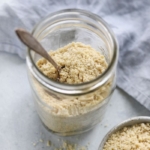
How to Make Almond Flour (Cheaper than Store-Bought!)
Servings: 8 servings
Calories: 167kcal
Here's how to make ALMOND FLOUR at home in just minutes! It's a great gluten-free and grain-free option used in low-carb baking. I love that it's high in protein and monosaturated fats.
Print Recipe
Add to Collection
Ingredients
- 8 ounces blanched almonds , whole or slivered
Instructions
- Place the blanched almonds in a high-speed blender or food processor, and process until they are finely ground. If using a high-speed blender, be sure not to over-process as the almonds will eventually start to release their oils and become almond butter.
- For best results, do not blend more than 8 ounces of almonds at a time. (I tried using 16 ounces and couldn't get them evenly ground.) For the most finely-ground results, I've found a blender works best, but the flour I made in the food processor also works for making almond flour recipes-- the final product is just slightly grainier.
- Store leftover almond flour in an airtight container in a dark pantry, or better yet in the fridge or freezer for the longest shelf life. Almond flour can keep well for up to one year if it's not exposed to heat or moisture.
Nutrition
Calories: 167kcal | Carbohydrates: 5g | Protein: 6g | Fat: 14g | Saturated Fat: 1g | Sodium: 5mg | Potassium: 186mg | Fiber: 2g | Sugar: 1g | Calcium: 67mg | Iron: 0.9mg